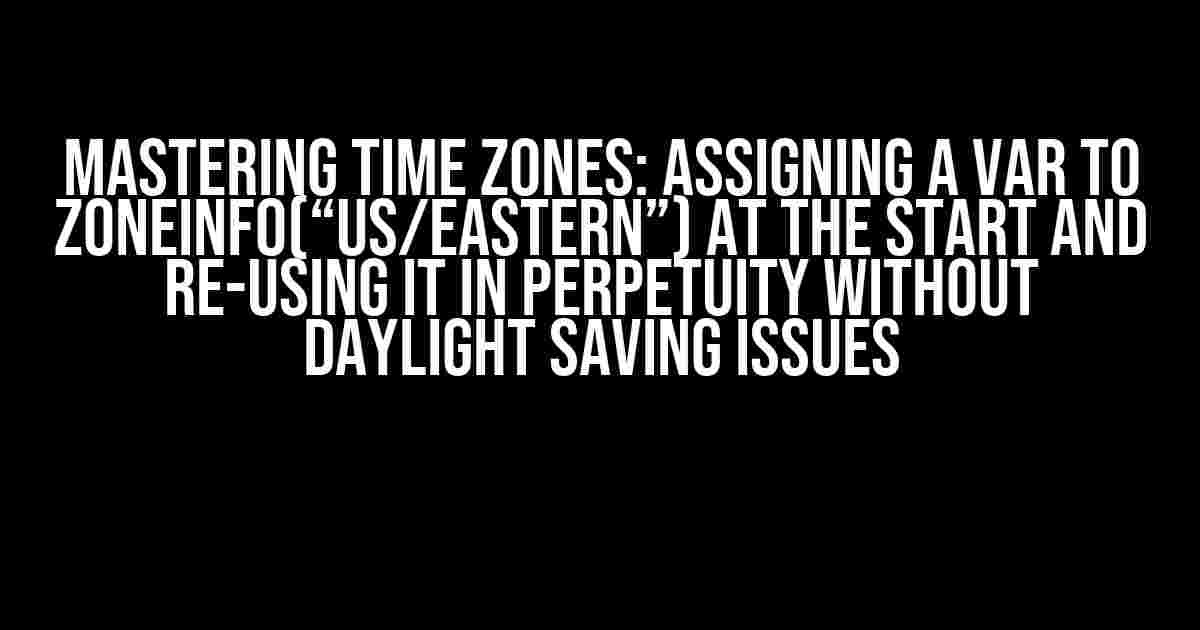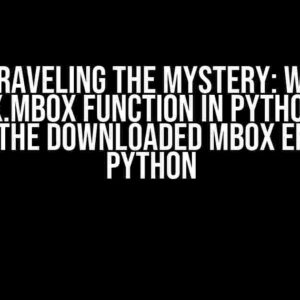Working with time zones can be a daunting task, especially when dealing with daylight saving issues. In this article, we’ll delve into the world of time zones and explore how to assign a var to ZoneInfo(“US/Eastern”) at the start and re-use it in perpetuity without running into those pesky daylight saving issues.
Understanding Time Zones and ZoneInfo
Before we dive into the solution, let’s take a step back and understand the basics of time zones and ZoneInfo.
A time zone is a region on Earth that follows a uniform standard time, usually based on the mean solar time at a specific meridian. Time zones are identified by their offset from Coordinated Universal Time (UTC), ranging from UTC-12 (which is 12 hours behind UTC) to UTC+12 (which is 12 hours ahead of UTC).
ZoneInfo, on the other hand, is a Python library that provides a way to work with time zones in a more efficient and accurate manner. It allows you to create time zone objects that can be used to convert dates and times between different time zones.
The Problem with Daylight Saving Time (DST)
Daylight Saving Time (DST) is the practice of temporarily advancing clocks during the summer months by one hour so that people can make the most of the sunlight during their waking hours. While DST is a great idea in theory, it can cause headaches for developers working with time zones.
The issue with DST is that it can cause ambiguous times, where a single clock time can correspond to two different UTC times. For example, in the US/Eastern time zone, the clock time 2:00 AM on March 13, 2022, can correspond to both 06:00 UTC on March 13, 2022, and 07:00 UTC on March 13, 2022, due to the DST transition.
Assigning a var to ZoneInfo(“US/Eastern”)
Now that we understand the basics of time zones and ZoneInfo, let’s create a Python script that assigns a var to ZoneInfo(“US/Eastern”):
import zoneinfo
us_eastern = zoneinfo.ZoneInfo("US/Eastern")
In this example, we import the `zoneinfo` library and create a time zone object called `us_eastern` that represents the US/Eastern time zone.
Re-using the var in perpetuity without daylight saving issues
Now that we have our `us_eastern` var, let’s explore how to re-use it in perpetuity without running into daylight saving issues.
Converting dates and times to UTC
One of the best ways to avoid DST issues is to convert dates and times to UTC, which is not affected by DST. We can use the `us_eastern` var to convert dates and times to UTC:
from datetime import datetime
# Create a date and time object in the US/Eastern time zone
dt = datetime(2022, 3, 13, 2, 0, 0, tzinfo=us_eastern)
# Convert the date and time to UTC
utc_dt = dt.astimezone(zoneinfo.ZoneInfo("UTC"))
print(utc_dt) # Output: 2022-03-13 06:00:00+00:00
In this example, we create a date and time object in the US/Eastern time zone using the `datetime` constructor and the `us_eastern` var as the `tzinfo` argument. We then convert the date and time to UTC using the `astimezone` method and the `ZoneInfo(“UTC”)` object.
Avoiding DST Ambiguities
To avoid DST ambiguities, we can use the `zoneinfo` library’s `Fold` class to determine the correct UTC offset for a given date and time:
from zoneinfo._c_zoneinfo import Fold
fold = Fold(us_eastern, datetime(2022, 3, 13, 2, 0, 0))
print(fold.utcoffset) # Output: 5 hours (or -300 minutes)
In this example, we create a `Fold` object using the `us_eastern` var and a date and time object. The `utcoffset` attribute of the `Fold` object returns the correct UTC offset for the given date and time, taking into account DST rules.
Using the var with other libraries
The `us_eastern` var can be used with other libraries that support time zones, such as Pandas and Matplotlib. For example, we can use the `us_eastern` var to set the time zone of a Pandas Timestamp object:
import pandas as pd
ts = pd.Timestamp(2022, 3, 13, 2, 0, 0, tz=us_eastern)
print(ts) # Output: 2022-03-13 02:00:00-05:00
In this example, we create a Pandas Timestamp object using the `us_eastern` var as the `tz` argument. The resulting Timestamp object has the correct time zone information, including the DST offset.
Best Practices for Working with Time Zones
To avoid headaches when working with time zones, follow these best practices:
-
Always use a specific time zone object, such as ZoneInfo(“US/Eastern”), instead of relying on the system’s default time zone.
-
Convert dates and times to UTC whenever possible to avoid DST ambiguities.
-
Use the `zoneinfo` library’s `Fold` class to determine the correct UTC offset for a given date and time.
-
Store dates and times in UTC format, and convert to local time zones only when necessary.
-
Avoid using naive date and time objects, which do not have time zone information.
-
Test your code with different time zones and DST scenarios to ensure it works correctly.
Conclusion
In this article, we’ve explored how to assign a var to ZoneInfo(“US/Eastern”) at the start and re-use it in perpetuity without daylight saving issues. By following best practices and using the `zoneinfo` library, you can work with time zones with confidence and avoid common pitfalls.
Remember to always convert dates and times to UTC, use the `Fold` class to determine the correct UTC offset, and store dates and times in UTC format. With these strategies in place, you’ll be able to tackle even the most complex time zone-related tasks with ease.
| Time Zone | UTC Offset |
|---|---|
| US/Eastern | -5 hours (standard time), -4 hours (DST) |
| US/Central | -6 hours (standard time), -5 hours (DST) |
| US/Pacific | -8 hours (standard time), -7 hours (DST) |
In this table, we’ve listed some common time zones in the United States, along with their UTC offsets. Remember to adjust the UTC offset according to the DST rules for each time zone.
-
ZoneInfo documentation: https://zoneinfo.readthedocs.io/en/stable/
-
Pandas documentation: https://pandas.pydata.org/pandas-docs/stable/user_guide/timestamps.html
-
Matplotlib documentation: https://matplotlib.org/stable/tutorials/text/date.html
Here are 5 Questions and Answers about “Assigning a var to ZoneInfo(“US/Eastern”) at the start and re-using it in perpetuity without daylight saving issues?”
Frequently Asked Question
Get the scoop on using ZoneInfo(“US/Eastern”) without worrying about daylight saving issues!
Why is it okay to assign ZoneInfo(“US/Eastern”) to a variable at the start?
It’s perfectly fine to assign ZoneInfo(“US/Eastern”) to a variable at the start because the ZoneInfo object is immutable, meaning its properties and behavior won’t change once it’s created. This ensures that your timezone information remains consistent throughout your program’s execution.
Will reusing the ZoneInfo variable lead to daylight saving issues?
No, reusing the ZoneInfo variable won’t cause daylight saving issues. The ZoneInfo object takes care of handling daylight saving time (DST) transitions automatically, so you can reuse it without worrying about manual adjustments.
Does the ZoneInfo object update its DST rules automatically?
Yes, the ZoneInfo object updates its DST rules automatically based on the most recent IANA timezone database. This means you don’t need to worry about keeping your timezone information up-to-date – it’s handled for you!
Can I use the same ZoneInfo variable across multiple threads or processes?
Yes, you can safely reuse the same ZoneInfo variable across multiple threads or processes. As an immutable object, it’s thread-safe and can be shared without worrying about concurrency issues.
Are there any performance benefits to reusing the ZoneInfo variable?
Yes, reusing the ZoneInfo variable can provide a minor performance benefit since it avoids the overhead of creating a new ZoneInfo object every time you need it. This might be particularly noticeable in high-performance or real-time applications.




